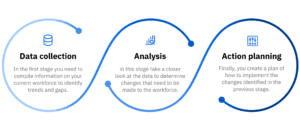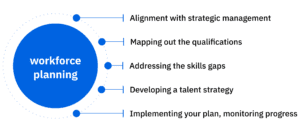Workforce planning: Redefine your company’s future
This article will explore why workforce planning software is essential for shaping your organization’s future and offer tips on getting started.

Organizations are changing how they source talent, define jobs, and design work. As a result, workforce planning has become more critical than ever before. With so much change on the horizon it is crucial to plan how your organization will adapt. This article will explore why workforce planning software is essential for shaping your organization’s future and offer tips on getting started.
What is workforce planning?Copied

Strategic workforce planning is long-term planning that takes into account an organization’s overall business goals.
It looks at where the company wants to be in the future and identifies the type and number of employees needed to get there.
Operational workforce planning, on the other hand, is short-term planning that focuses on the day-to-day or week-to-week staffing needs of the organization. Organizations typically use both types of workforce planning as they complement each other well.
Why is strategic workforce planning important?Copied
The WTW 2022 Reimagining Work and Rewards Survey shows substantial increases in the percentages of employers expecting to make extensive transformations in the following strategic areas:
- Optimizing work and job design (+50%)
- Resetting the Total Rewards philosophy (+80%)
- Defining careers (+90%)
Workforce planning is vital for several reasons, most importantly:
- It helps to ensure that an organization has the right mix of employees to meet its current and future needs.
- Workforce planning also helps to identify skills gaps within an organization and develop strategies for addressing them.
- Additionally, workforce planning can help to identify trends that may impact an organization’s workforce, such as retirements, technological advancement, and changes in the market.
- It boosts employee productivity and engagement as employees are more likely to be successful in roles that match their skills and interests.
By considering these factors, organizations can be better prepared to manage their workforce effectively.
What are the three stages of workforce planning?Copied

The three stages of workforce management are crucial to ensuring the success of your business. By understanding and optimizing each phase, you can create a workforce planning strategy that will help your business run smoothly and efficiently. Let’s take a closer look at each one:
- Data collection
In the data collection stage businesses compile information on their current workforce including job descriptions, performance reviews, and demographic details. This data is then used to identify trends and gaps in the workforce.
- Analysis
In this stage organizations take a closer look at the data to determine changes that need to be made to the workforce. This may involve creating new job roles or facilitating training for existing employees to fill skills gaps.
- Action planning
Finally, in the action planning stage businesses create a plan of how to implement the changes identified in the previous stage. This plan typically involves recruiting new employees and providing training to existing employees.
What are the five key elements of workforce planning?Copied
Workforce planning software helps you to ensure that your company has the right people in the right roles at the right time.
Here are the five key elements of workforce planning:
1. Alignment with strategic management
The first step in workforce planning is understanding the critical mission goals and future objectives set by organization leadership and how the workforce needs to be aligned to achieve them.
It is essential because it ensures that everyone involved in the workforce planning process is on the same page regarding the company’s direction and what needs to be done to achieve the desired outcomes.
2. Mapping out the qualifications
Your needs locally and globally are an important part of any workforce strategy. By mapping out skills and qualifications managers can find the right mix for success.
Workforce planning software simplifies this process with a skills and requirements library feature. This type of software helps to manage your workforce, it is invaluable in large and complex organizational structures. Moreover, it provides insight into the qualifications and certifications required.

3. Addressing the skills gaps
You can address the skills gaps in your organization in several ways. First, identify which skills are most needed within the organization. This information can then be used to develop training and development programs that target those specific skills.
Additionally, monitor employee performance and identify areas where they are underperforming.
By using workforce planning software to address the skills gaps in your organization, you can ensure that your employees have the skills they need to be successful, and you can also identify high performance.
4. Developing a talent strategy
Identifying the company’s core values is one of the first steps in creating a workforce plan. These values should be reflected in all aspects of the employee experience from recruitment to onboarding to retention.
Once these values have been identified they can be used to attract candidates who are a good fit for the organization. The next step is to create a process for identifying and developing talent.
This may include implementing training and development programs or partnering with colleges and universities.
5. Implementing your plan, measuring and monitoring progress
Workforce planning accelerates growth, but you need the processes and systems to support it. Communicating your goals to employees and getting their buy-in and feedback is crucial.
With careful planning and execution, you can create a workforce aligned with your business goals and poised for success. Moreover, monitoring progress ensures that solutions have their intended impact.
Set key performance indicators (KPIs), so you can track whether your solutions are effectively closing gaps and helping your organization to reach its targets. It helps to periodically revisit your workforce plan to make changes based on new developments or updated information.
Three trends affecting workforce planningCopied
When planning your workforce there are three main pillars to take into account:
The ever-changing world of work
The way we work is changing rapidly. Thanks to technological advances we now have more flexibility regarding where and how we work. However, as the border between our personal and professional lives continues to diminish, traditional 9–5 workdays are outdated.
With organizations expecting 48% of their workforce to work remotely or hybrid, strategic workforce planning is necessary to plan for new ways of working and avoid risks in the next three years.
The global talent shortage
The war for talent is only getting more competitive. According to a McKinsey Global Survey, 44% of organizations expect to face skills gaps within the next five years.
As a result, many companies are turning to contingent workers, or gig workers, to fill the gaps in their workforce. While this can be an effective short-term solution, it is not a sustainable long-term strategy.
To attract and retain top talent you need a clear plan for employee development and to provide them with opportunities for career growth.
Defining careers
As the workplace continues to evolve, so must the way we think about careers. Gone are the days when employees would spend their entire working lives with one company, climbing the ladder of success in a linear fashion.
Today, organizations are adopting a more flexible career approach, supporting employees to move laterally and forward across different roles. This helps employees stay engaged and motivated and allows businesses to be more agile in the face of change.
A recent survey by Willis Towers Watson found that 92% of employers believe that enhancing employee experience (EX) will be essential over the next three years. This shift in thinking will significantly impact how we define and pursue careers in the years to come.
Tips for workforce planning in 2023 Copied
Workforce planning can be complex and challenging, but it can considerably impact your organization’s success.
By keeping our five tips in mind, you can develop a plan to help you navigate change and stay ahead of your competition.
- Keep your finger on the pulse of change
- Understand your company’s unique needs
- Develop a clear vision for the future
- Communicate and collaborate with your team
- Be flexible and adaptable in your approach
Centralize your employee data with AG5 softwareCopied
AG5 software can help you with your workforce planning. Our software provides a centralized platform for managing employee data, tracking skills and qualifications, and identifying training and development needs.
We also offer a range of tools to help you assess your workforces, such as our Job Description Builder and Competency Assessment Tool.
Schedule your free demo today to learn more about how AG5 software can help you manage your workforce!

